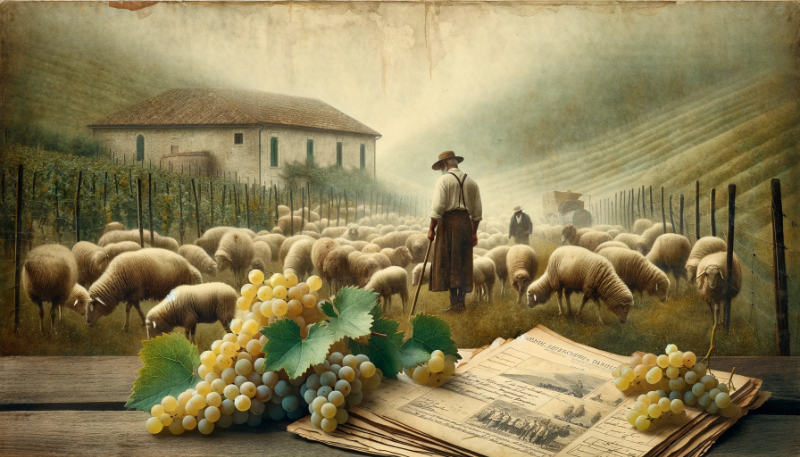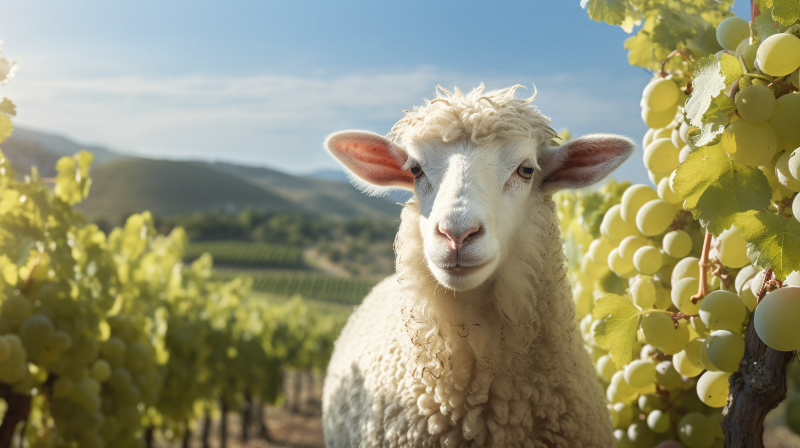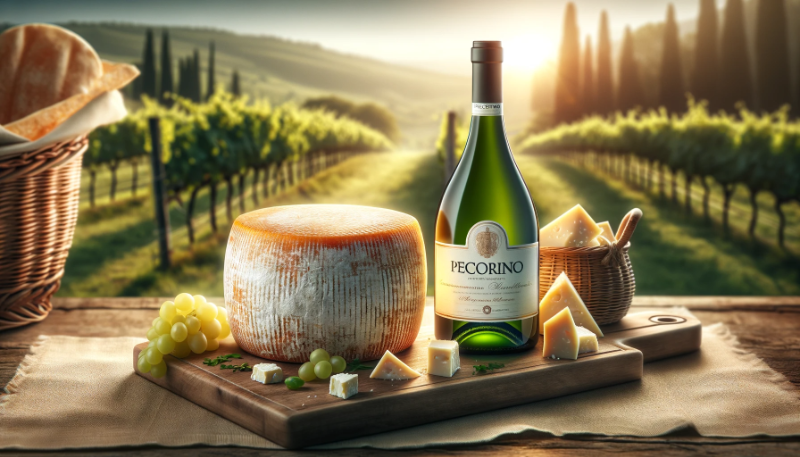In the tapestry of wine's vast narrative, certain names spark curiosity and evoke a rich blend of culture and folklore. The Pecorino, a white wine that gracefully straddles the lush regions of Marche and Abruzzo in Italy, stands as a testament to such a narrative. The etymology of 'Pecorino' has long intrigued connoisseurs and casual drinkers alike, beckoning the question: Why is a wine named akin to the famed sheep's milk cheese? As the British palate continues to embrace a cornucopia of international wines, let's delve into the tale behind Pecorino's name, exploring theories that span from humble shepherds to the characteristics of the wine itself.
Drawing from the oenophile’s lexicon and the pastoral landscapes of Italy, we unravel the mystery enshrouded within the Pecorino grape’s moniker. This variety, once undervalued and nearly lost to time, has re-emerged since the 1980s as a vintner's treasure, championed for its quality production. Amidst the more endearing hypotheses on the origin of its name, one suggests a connection to the 'pecorari', shepherds whose simplistic lifestyle was reflected in the once-unassuming grape. Conversely, a more gustatory proposition links the wine to its effervescent character, akin to the zestful tang of Pecorino cheese.
While the British enjoy a good tale and a better glass, it's this blend of history and taste that renders the Pecorino grape an enigmatic player in the world of winemaking. Whether it's the evocative image of sheep sidling through vineyards or the unique shape of the grape clusters that mimic a sheep's head, the name 'Pecorino' carries a narrative worth savouring, much like the wine itself.
Let us embark on a journey to uncork the essence of this appellation and what it tells us about the whimsical interplay between nature, culture, and the grapes we love to cherish.
From Shepherds to Vines: The Rustic Roots of Pecorino Wine
As we further explore the Pecorino grape’s enigmatic history, the first hypothesis proposes an intriguing pastoral origin for its name. It’s suggested that the grape was once considered modest, much like the 'pecorari', or shepherds of Italy’s countryside. These individuals, often regarded with a kind of rustic respect, were the custodians of traditions and, perhaps, of the vine itself. Their simple lifestyle and their close association with the land is mirrored in the Pecorino grape’s own journey from obscurity to recognition.

This perspective paints a picture where the grape's worth, much like that of the shepherds, was underestimated. The narrative posits that the grape was named 'Pecorino' as a nod to these humble herdsmen, with the term 'pecorari' historically used in a somewhat derogatory fashion to refer to shepherds. This connection to the earthy, pastoral life resonates with a British audience who appreciates the rustic and genuine origins of what they consume, be it a reflection of the terroir in their glass or the heritage of the countryside on their plates
The simplicity attributed to the Pecorino grape may have been a reflection of the shepherds’ unpretentious existence, yet it encapsulates the beauty of the wine's revival and current stature. The once under appreciated varietal has, over the decades, risen to become a symbol of winemaking finesse, embraced by those who seek authenticity and storied flavours.
To sip Pecorino wine is to taste the soul of the Italian agrarian landscape, a land where sheep once roamed between the rows of vines, and where the spirit of the 'pecorari' is said to linger in every glass. It's a homage to a time when the value of wine was intertwined with the lives of those who tended the land, a tradition that continues to resonate with the discerning tastes of British enthusiasts, offering a toast to the pastoral past with every pour.
A Sparkling Pairing: The Pecorino Grape and Effervescence
Venturing deeper into the folklore behind Pecorino's nomenclature, we come across a second hypothesis, steeped in the sensory experience of taste. This conjecture posits that the grape variety was named 'Pecorino' in light of its ideal pairing with the eponymous cheese, tied together by a shared vivacity in flavour and texture.
In the vein of this theory, the narrative suggests that the wine, like the sheep's milk cheese, is known for its distinctive, sprightly effervescence. Historically, due to the climatic conditions of its production zones, wines made from the Pecorino grape often underwent a secondary fermentation come the warmth of spring. This process imbued them with a lively, 'frizzante', or sparkling character, reminiscent of the zesty sharpness for which Pecorino cheese is celebrated.
Linguistic evidence lends weight to this hypothesis, suggesting a bygone synonymy between the terms 'piccante' — denoting the robust flavour profile of sheep's cheese — and 'frizzante', referring to the wine's spirited fizz. Indeed, this lexical connection persists in modern parlance, where a 'frizzante' attribute transcends gastronomy, used to describe anything imbued with a zestful, lively quality.
This theory appeals to the British affinity for playful wordplay and the appreciation of a good gastronomic match. The idea that the Pecorino wine might owe its name to an age-old tradition of pairing with cheese caters to the U.K.’s love affair with both storied wines and artisanal cheeses. It is a tantalising thought that to sip on a glass of Pecorino is to participate in a historic ritual of pairing, where the vivacity of the wine meets the creamy tang of the cheese, a coupling that has perhaps been a joyous accident of linguistic and culinary evolution.
As we savour Pecorino wine, we celebrate not just the joy of a perfect pairing, but the continuation of an enological narrative that captures the imagination, much to the delight of British connoisseurs and casual sippers alike.
Sheep's Delight: Could Pecorino Grapes Be a Snack for the Flock?
Ever wondered if sheep like a tipple? Well, not exactly, but there’s a charming theory that the Pecorino grape got its name because these fluffy farm-dwellers couldn't resist a bunch of its sweet grapes. The story goes that during transhumance – that's the fancy word for moving sheep from one grazing ground to another to cope with the changing seasons – the sheep would munch on the ripe Pecorino grapes they came across.
It’s kind of funny to picture, isn’t it? A flock of sheep, historically celebrated for their milk and wool, turning into a bunch of grape gourmands. But not everyone buys this pastoral picture. Some say it's just a tall tale, noting that the grape bunches usually hang too high off the ground for the sheep to reach. Others point to historical rows between shepherds and vineyard owners who weren't too thrilled about these woolly intruders treating their grapes like a snack bar.
So, while it’s an amusing image, picturing sheep wreaking havoc in Italian vineyards, it's more likely this hypothesis has been romanticized over the years. The sheep might have enjoyed the odd grape here and there, but it's probably not the main reason we call the grape Pecorino. It's a bit like blaming the fox for why your favourite football team lost – it's an easy scapegoat (or scape-sheep?).
However, this grape variety has definitely made a journey as epic as any sheep migration, coming back from near extinction to become one of Italy's beloved white wines. And while we may not be shepherds overseeing a flock, pouring a glass of Pecorino can feel like joining a centuries-old tradition – even if we’re just pairing it with a good cheese rather than grazing on a hillside.
The Grapevine's Own Sheep's Head: A Curious Resemblance in Pecorino
Nestled within the vine-clad hills of Italy, the Pecorino grape continues to intrigue with its pastoral name. We've pondered over shepherds, savoured the notion of sprightly wines paired with sharp cheeses, and chuckled at the thought of sheep snacking on sweet grapes. Yet another whimsical theory ripe for British musings proposes that the name 'Pecorino' stems from a rather visual inspiration—the elongated shape of the grape clusters themselves.

In a nod to nature's own artistry, it is said that the Pecorino grape's bunches—comprised of a more substantial central body flanked by two lateral outgrowths—bear a striking resemblance to a sheep's head. As fanciful as it may sound, one can't help but marvel at the grape's silhouette, which, akin to a vinous Rorschach test, evokes the pastoral icon it’s named after. This semblance to a sheep's head might not just be a coincidence, but rather a poetic tribute by viticulturists of yore, who perhaps saw in the curves and contours of the grapes the very essence of their agrarian surroundings.
This theory delights with its visual quirkiness, appealing to the romantic in us who yearn for a time when the rhythm of life was dictated by the land, and when winegrowers might have seen reflections of their environment in the fruits of their labour. It speaks to the U.K.’s affection for the quaint and picturesque—a love for finding the extraordinary in the contours of the natural world.
To regard a cluster of Pecorino grapes is to observe a story that transcends the mere act of viticulture, to embrace a tale woven into the very landscape of Italy's heartland. So next time a British wine lover lifts a glass of Pecorino, perhaps they'll muse not just on the wine's crispness, but also on the serendipitous shape of the clusters that once hung in the Italian sun—a charming example of life’s tendency to imitate art, right down to our last sip.









